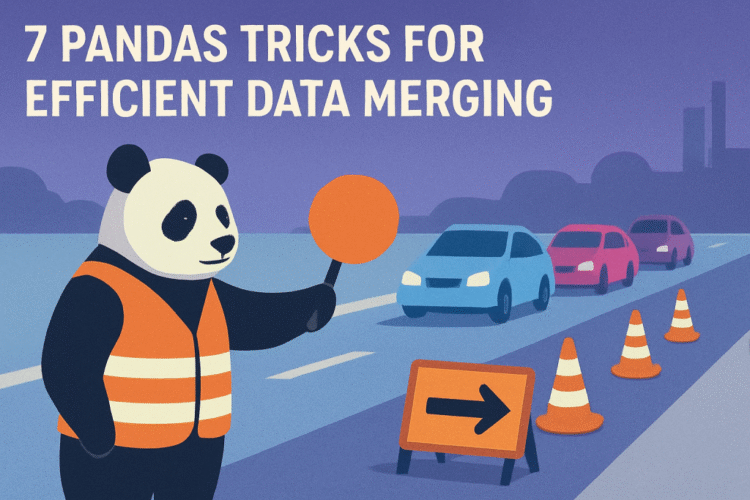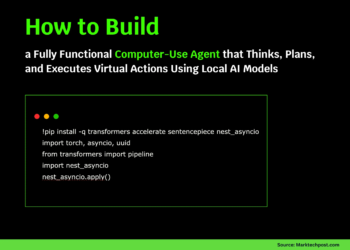
7 Pandas Tricks for Efficient Data Merging
Image by Editor | ChatGPT
Introduction
Data merging is the process of combining data from different sources into a unified dataset. In many data science workflows where relevant information is scattered across multiple tables or files — for instance, bank customer profiles and their transaction histories — data merging becomes imperative to unlock deeper insights and facilitate impactful analysis. Yet efficiently executing data merging processes can be arduous, due to inconsistencies, heterogeneous data formats, or simply owing to the sheer size of the datasets involved.
This article uncovers seven practical Pandas tricks to speed up your data merging process, allowing you to focus more on other critical stages of your data science and machine learning workflows. Needless to say, since the Pandas library plays a starring role in the below code examples, make sure you “import pandas as pd” first!
1. Safe One-to-One Joins with merge()
Using Pandas’ merge() function to merge two datasets with a key attribute or identifier in common can be made efficient and robust by setting the validate="one_to_one" argument, which ensures the merging key has unique values in both dataframes and catches possible duplicate errors, preventing their propagation to later data analysis stages.
|
left = pd.DataFrame({‘id’:[1,2,3], ‘name’:[‘Ana’,‘Bo’,‘Cy’]}) right = pd.DataFrame({‘id’:[1,2,3], ‘spent’:[10,20,30]})
merged = pd.merge(left, right, on=‘id’, how=‘left’, validate=‘one_to_one’) |
Our example creates two small dataframes on the fly, but you can try it out with your own “left” and “right” dataframes, provided they have a common merging key (in our example, the 'id' column).
Eager for some practice? Try different join modalities in the how, like right, outer, or inner joins, also try replacing the id value of 3 in either one of the dataframes, and see how it affects the merging results. I also encourage you to experiment similarly with the next four examples.
2. Index-based Joins with DataFrame.join()
Turning the common merging keys across dataframes into indexes contributes to faster merging, especially when multiple joins are involved. The following example sets the merging keys as the indices before using one of the dataframe’s join() method to merge it with the other. Again, different join modalities can be considered.
|
users = pd.DataFrame({‘user_id’:[101,102,103], ‘name’:[‘Ada’,‘Ben’,‘Cal’]}).set_index(‘user_id’) scores = pd.DataFrame({‘user_id’:[101,103], ‘score’:[88,91]}).set_index(‘user_id’)
joined = users.join(scores, how=‘left’) |
3. Time-aware Joins with merge_asof()
In highly granular time series data, such as shopping orders and their associated tickets, exact timestamps may not always match. Therefore, instead of seeking an exact match on merging keys (i.e., the time), a nearest-key approach is better. This can be done efficiently with the merge_asof() function, as follows:
|
tickets = pd.DataFrame({‘t’:[1,3,7], ‘price’:[100,102,101]}) orders = pd.DataFrame({‘t’:[2,4,6], ‘qty’:[5,2,8]})
asof_merged = pd.merge_asof(orders.sort_values(‘t’), tickets.sort_values(‘t’), on=‘t’, direction=‘backward’) |
4. Fast Lookups with Series.map()
When you need to add a single column from a lookup table (like a Pandas Series mapping product IDs to names), the map() method is a faster and cleaner alternative to a full join. Here’s how:
|
orders = pd.DataFrame({‘product_id’:[2001,2002,2001,2003]}) product_lookup = pd.Series({2001:‘Laptop’, 2002:‘Headphones’, 2003:‘Monitor’})
orders[‘product_name’] = orders[‘product_id’].map(product_lookup) |
5. Prevent Unintended Merges with drop_duplicates()
Unintended many-to-many merges can often happen if we overlook possibly duplicate keys (sometimes accidentally) that, ultimately, shouldn’t be there. A careful analysis of your data before merging and ensuring possible duplicates are dropped can prevent explosive row counts and memory spikes when working with large datasets.
|
orders = pd.DataFrame({‘id’:[1,1,2], ‘item’:[‘apple’,‘banana’,‘cherry’]}) customers = pd.DataFrame({‘id’:[1,2,2], ‘name’:[‘Alice’,‘Bob’,‘Bob-dupli’]})
customers = customers.drop_duplicates(subset=‘id’) merged = pd.merge(orders, customers, on=‘id’, how=‘left’, validate=‘many_to_one’) |
6. Quick Key Matching with CategoricalDtype
Another approach to reduce memory spikes and speed up comparisons made during merging is to cast merging keys as categorical variables using a CategoricalDtype object. If your dataset has keys consisting of large and repetitive strings like alphanumeric customer codes, you’ll really feel the difference by applying this trick before merging:
|
left = pd.DataFrame({‘k’:[‘a’,‘b’,‘c’,‘a’]}) right = pd.DataFrame({‘k’:[‘a’,‘b’], ‘v’:[1,2]})
cat = pd.api.types.CategoricalDtype(categories=right[‘k’].unique()) left[‘k’] = left[‘k’].astype(cat) right[‘k’] = right[‘k’].astype(cat)
merged = pd.merge(left, right, on=‘k’, how=‘left’) |
7. Trim Join Payload with loc[] projections
It’s much simpler than it sounds, trust me. This trick, especially applicable to datasets containing a large number of features, consists of selecting only the necessary columns before merging. The reduction in data shuffling, comparisons, and memory storage can make a real difference by simply adding a couple of column-level loc[] projections to the process:
|
1 2 3 4 5 6 7 8 9 10 11 12 13 14 15 16 17 |
sales = pd.DataFrame({ ‘order_id’:[101,102,103], ‘customer_id’:[1,2,3], ‘amount’:[250,120,320], ‘discount_code’:[‘SPRING’,‘NONE’,‘NONE’] })
customers = pd.DataFrame({ ‘customer_id’:[1,2,3], ‘region’:[‘EU’,‘US’,‘APAC’], ‘notes’:[‘VIP’,‘Late payer’,‘New customer’] })
customers_selected = customers.loc[:, [‘customer_id’,‘region’]] sales_selected = sales.loc[:, [‘order_id’,‘customer_id’,‘amount’]]
merged = pd.merge(sales_selected, customers_selected, on=‘customer_id’, how=‘left’) |
Wrapping Up
By applying the seven Pandas tricks from this article to large datasets, you can dramatically improve the efficiency of your data merging processes. Below is a quick recap of what we learned.
| Trick | Value |
|---|---|
pd.merge() |
One-to-one key validation to prevent many-to-many explosions wasting time and memory. |
DataFrame.join() |
Direct index-based joins reduce key-alignment overhead and simplify multi-join chains. |
pd.merge_asof() |
Sorted nearest-key joins on time series data without burdensome resampling. |
Series.map() |
Lookup-based key-value enrichment is faster than a full DataFrame join. |
DataFrame.drop_duplicates() |
Removing duplicate keys prevents many-to-many blow-ups and unnecessary processing. |
CategoricalDtype |
Casting complex string keys to a categorical type saves memory and speeds up equality comparisons. |
DataFrame.loc[] |
Selecting only needed columns before merging. |
















![GEO, AEO, LLMO: Separating Fact from Fiction & How to Win AI Search [MozCon 2025 Speaker Series]](https://mgrowtech.com/wp-content/uploads/2025/09/MozCon-25-Speaker-Profile-Cards-13-120x86.png)

